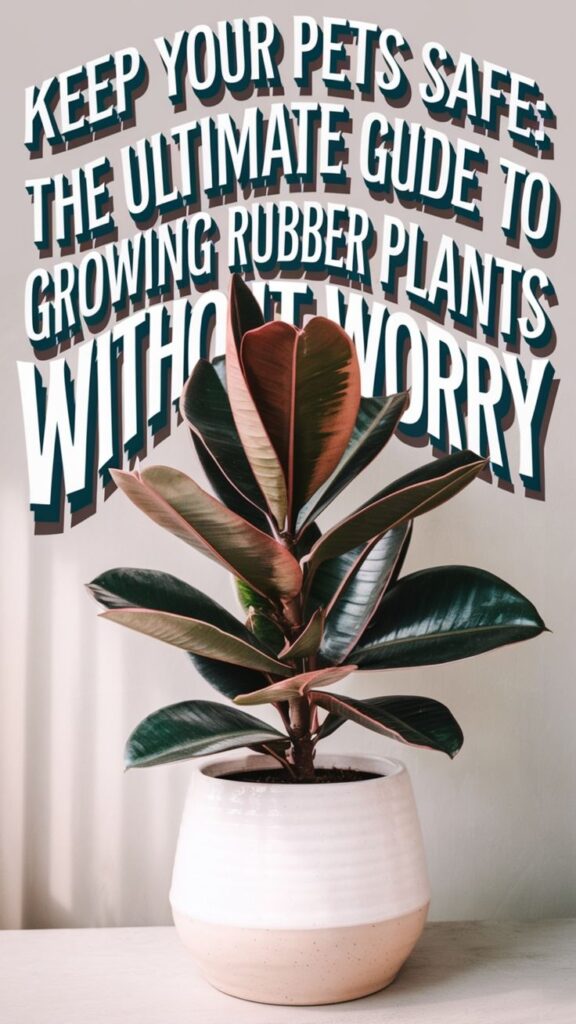While rubber plants (Ficus elastica) can filter indoor air pollutants by up to 40%, they contain a toxic sap that can harm your curious pets if ingested. You’ll need to balance your plant’s health benefits with your pet’s safety through strategic placement and preventive measures. There’s a reliable system of precautions you can take to guarantee both your rubber plant and furry friends thrive under the same roof, starting with some simple adjustments to your home setup.

Contents
Understanding Rubber Plant Toxicity and Pet Risk Levels
Rubber plants (Ficus elastica) contain a milky sap that is toxic to both cats and dogs. When ingested, this sap can cause oral irritation, excessive drooling, vomiting, and in some cases, digestive upset. The toxic compound in rubber plants is a proteolytic enzyme that can also cause skin irritation if the sap comes into direct contact with an animal’s skin or mucous membranes.
The risk level varies depending on the amount ingested and the size of the pet, with smaller animals generally being more vulnerable to toxic effects. While rubber plant poisoning is rarely fatal, it can cause significant discomfort and should be treated as a serious concern. Most pets will experience immediate irritation upon contact, which often prevents them from consuming large quantities of the plant. However, curious puppies and kittens may be more likely to chew on leaves or stems, putting them at higher risk for exposure.
Strategic Placement Tips for Pet-Safe Plant Displays
Strategic plant placement is essential when keeping rubber plants in homes with pets. Placing rubber plants on elevated surfaces like tall plant stands, hanging baskets, or high shelves keeps them out of reach while still allowing them to receive proper light. Window sills above counter height and secured wall-mounted planters also provide safe display options that prevent direct pet access.
Creating designated plant zones in pet-restricted areas offers another effective solution. This can include closed sunrooms, home offices with doors, or sectioned-off portions of rooms using decorative screens or indoor fencing. When using these zones, verify the barriers are stable and cannot be knocked over by curious pets attempting to reach the plants.
Training Your Pets to Avoid Rubber Plants
Training pets to avoid rubber plants requires consistency, positive reinforcement, and creating clear boundaries. Use deterrent sprays specifically designed for pets around the base of the plant, or place aluminum foil around the pot, as many animals dislike its texture and sound. When pets approach the plant, firmly say “no” and redirect their attention to appropriate toys or scratching posts.
For cats and dogs, establish a designated plant-free zone where they can safely play and explore. Reward them with treats and praise when they stay away from the rubber plant and play in their designated areas instead. If needed, place the rubber plant in an elevated location or behind a decorative barrier while training is ongoing, gradually making it more accessible as pets learn to avoid it.
Creating Physical Barriers and Deterrent Systems
Physical barriers and deterrent systems are essential for keeping pets away from rubber plants while maintaining an attractive living space. Simple solutions include placing rubber plants on elevated surfaces like plant stands, wall-mounted shelves, or hanging baskets that are out of reach of curious pets. Decorative plant cages or protective screens can also be positioned around the plants while still allowing them to receive adequate light and air circulation.
Natural and pet-safe deterrents can be used to discourage animals from approaching rubber plants. Commercial bitter sprays, diluted citrus solutions, or a light dusting of ground black pepper around the plant’s base can help keep pets at bay. Additionally, strategic placement of aluminum foil, double-sided tape, or plastic mats with slightly raised nubs around the plant area can create uncomfortable surfaces that pets will typically avoid.
Signs of Plant Toxicity and Emergency Response Steps
Signs of rubber plant toxicity in pets typically include drooling, vomiting, decreased appetite, and oral irritation due to the plant’s toxic sap. Some pets may also exhibit pawing at their mouth, difficulty swallowing, or general lethargy. In severe cases, pets might experience diarrhea, abdominal pain, or show signs of depression and weakness.
If pet owners notice any of these symptoms and suspect rubber plant poisoning, immediate action is essential. The first step is to remove any plant material from the pet’s mouth and rinse the oral cavity with cool water if possible. Contact a veterinarian or animal poison control center right away, and if instructed, transport the pet to an emergency veterinary clinic. Bringing a sample of the plant can help with identification and treatment.
